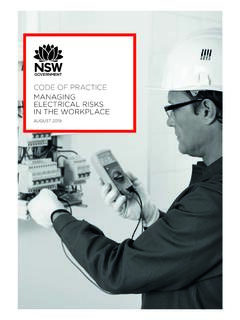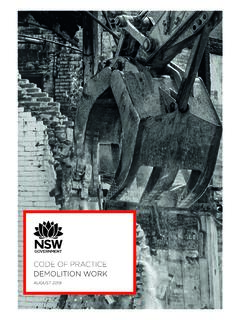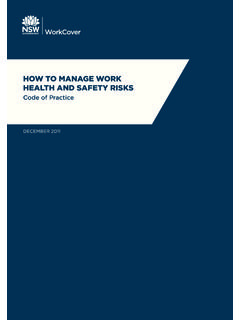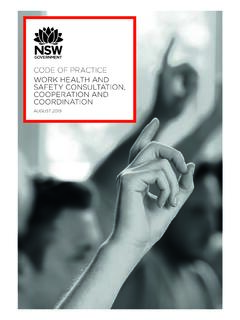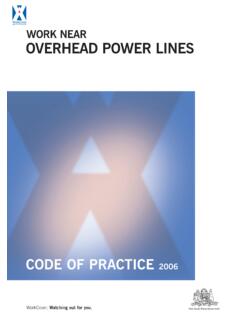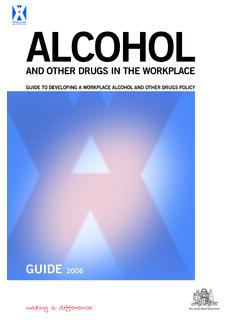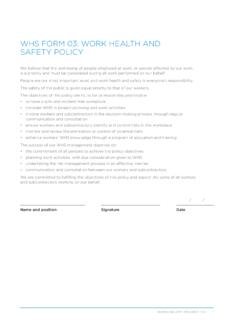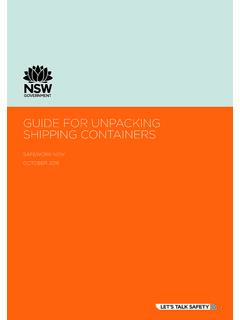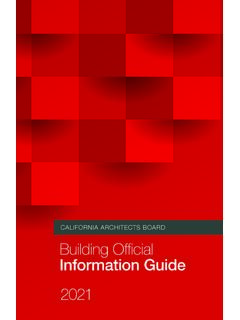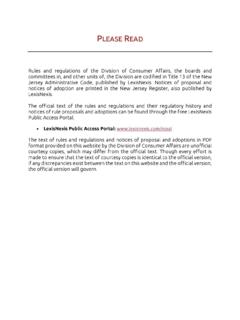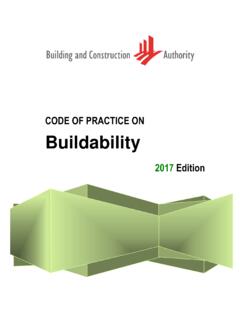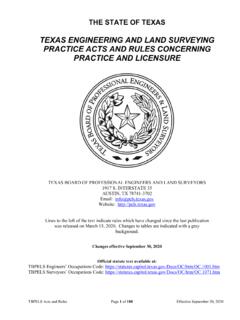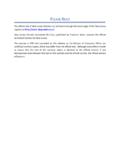Transcription of CODE OF PRACTICE - SafeWork NSW
1 CODE OF PRACTICECONSTRUCTION WORKAUGUST 2019 NSW note: This code is based on a national model code of PRACTICE developed by Safe Work Australia under the harmonisation of national work health and safety legislation and has been approved under section 274 of the NSW Work Health and Safety Act 2011. Notice of that approval was published in the NSW Government Gazette referring to this code of PRACTICE as Construction work (page 2695) on Friday 18 July 2014. This code of PRACTICE commenced on Friday 18 July amendments under section 274 of the NSW Work Health and Safety Act 2011 have been published and commenced as detailed in the list of amendments contained in this for the NSW Government logo, this copyright work is licensed under a Creative Commons Attribution-Non-Commercial Australia view a copy of this licence, visit are free to copy, communicate and adapt the work for non-commercial purposes, as long as you attribute the work to SafeWork NSW and abide by the other licence terms.
2 Contents Foreword .. 5 1. Introduction .. 6 What is construction work ? .. 6 What is not construction work ? .. 7 What is a structure ? .. 7 What is high risk construction work ? .. 8 What is a construction project ? .. 8 Who has health and safety duties relating to construction work? .. 9 What is involved in managing risks associated with construction work? .. 11 2. Specific duties relating to construction work .. 16 Persons conducting a business or 16 Officers .. 20 Workers .. 20 Other persons .. 20 3. The risk management process .. 21 Identifying hazards .. 21 Assessing the risks .. 21 Controlling the risks .. 22 Maintaining and reviewing control measures .. 24 4. Safe work method statements .. 25 What is a safe work method statement? .. 25 Preparing a SWMS .. 26 Implementing a SWMS .. 28 Reviewing a SWMS .. 29 5. WHS management plans for construction projects .. 30 What is a WHS management plan? .. 30 What must the WHS management plan contain?
3 30 How to prepare a WHS management plan .. 31 Informing people about the WHS management plan .. 31 Reviewing and revising a WHS management plan .. 31 Keeping the WHS management plan .. 32 6. Information, training, instruction and supervision .. 33 General construction induction training .. 33 Workplace specific induction training .. 34 Other training .. 35 Supervision .. 36 Construction work Code of PRACTICE Page 4 of 90 7. General workplace management arrangements .. 37 Appendix A Glossary .. 38 Appendix B Examples of construction work .. 41 Appendix C Examples of high risk construction work .. 44 Appendix D Design duties .. 46 Consulting, cooperating and coordinating activities with other duty holders .. 47 Calculation, testing or examination .. 47 Providing information .. 47 The designer s safety report .. 49 Appendix E Safe work method statement template Guidelines .. 50 Recommended steps for filling out the safe work method statement template .. 50 High risk construction work safe work method statement template.
4 52 Appendix F Sample of a completed Safe work method statement .. 54 Appendix G Preparing a WHS management plan .. 58 People with health and safety responsibilities .. 58 Appendix H WHS Management plan template .. 61 Appendix I Sample of a completed WHS Management 63 Appendix J Housing construction workplace management arrangements .. 67 Appendix K General construction workplace management arrangements .. 76 The work environment .. 76 Entry and exit .. 77 Work areas .. 77 Floors and surfaces .. 77 Lighting .. 77 Heat and cold .. 78 Essential services .. 78 Facilities at a construction workplace .. 79 First aid .. 81 Emergency planning .. 82 Personal protective equipment .. 83 Falling objects .. 84 Falls from heights .. 85 General construction workplace facilities .. 86 Amendments .. 89 Construction work Code of PRACTICE Page 5 of 90 Foreword This Code of PRACTICE on construction work is an approved code of PRACTICE under section 274 of the Work Health and Safety Act (the WHS Act).
5 An approved code of PRACTICE provides practical guidance on how to achieve the standards of work health and safety required under the WHS Act and the Work Health and Safety Regulation (the WHS Regulation) and effective ways to identify and manage risks. A code of PRACTICE can assist anyone who has a duty of care in the circumstances described in the code of PRACTICE . Following an approved code of PRACTICE will assist the duty holder to achieve compliance with the health and safety duties in the WHS Act and WHS Regulation, in relation to the subject matter of the code of PRACTICE . Like regulations, codes of PRACTICE deal with particular issues and may not cover all relevant hazards or risks. The health and safety duties require duty holders to consider all risks associated with work, not only those for which regulations and codes of PRACTICE exist. Codes of PRACTICE are admissible in court proceedings under the WHS Act and WHS Regulation. Courts may regard a code of PRACTICE as evidence of what is known about a hazard, risk, risk assessment or risk control and may rely on the code in determining what is reasonably practicable in the circumstances to which the code of PRACTICE relates.
6 For further information see the Interpretive Guideline: The meaning of reasonably practicable. Compliance with the WHS Act and WHS Regulation may be achieved by following another method, if it provides an equivalent or higher standard of work health and safety than the code. An inspector may refer to an approved code of PRACTICE when issuing an improvement or prohibition notice. Scope and application This Code is intended to be read by a person conducting a business or undertaking (PCBU). It provides practical guidance for PCBUs, including those persons who design, construct, import, supply or install plant or structures, on how to eliminate, or if that is not possible, minimise the risks relating to construction work. This Code may be a useful reference for other persons interested in the duties under the WHS Act and WHS Regulation that relate to construction work. This Code applies to all types of construction work and all workplaces covered by the WHS Act and WHS Regulation.
7 Housing construction work While the information and guidance contained in this code is relevant to every type of construction work, extra guidance marked with this symbol is provided for businesses in the housing construction sector. How to use this Code of PRACTICE This Code includes references to the legal requirements under the WHS Act and WHS Regulation. These are included for convenience only and should not be relied on in place of the full text of the WHS Act or WHS Regulation. The words must , requires or mandatory indicate a legal requirement exists that must be complied with. The word should is used in this Code to indicate a recommended course of action, while may is used to indicate an optional course of action. Construction work Code of PRACTICE Page 6 of 90 1. Introduction What is construction work ? WHS Regulation clause 289 Meaning of construction work Construction work is defined in the WHS Regulation as any work carried out in connection with the construction, alteration, conversion, fitting-out, commissioning, renovation, repair, maintenance, and refurbishment, demolition, decommissioning or dismantling of a structure.
8 Construction work can be commercial, civil or housing construction and includes the following: any installation or testing carried out in connection with an activity referred to in the above definition the removal from the workplace of any product or waste resulting from demolition the prefabrication or testing of elements, at a place specifically established for the construction work, for use in construction work the assembly of prefabricated elements to form a structure, or the disassembly of prefabricated elements forming part of a structure the installation, testing or maintenance of an essential service in relation to a structure any work connected with an excavation any work connected with any preparatory work or site preparation including landscaping as part of site preparation carried out in connection with an activity referred to in the above definition, or an activity referred to in the above definition, carried out on, under or near water including work on buoys and obstructions to navigation.
9 Contracts covering a project are a good guide to what activities are done in connection with construction. Examples include: work by architects or engineers in on-site offices or conducting on-site inspections, but not architects or engineers working in offices away from the construction site work by a mechanic on an excavator on-site and not in an isolated service area delivering building materials to different points on the site, but not making deliveries to a single designated delivery area excavating for a basement garage testing fire equipment on the construction site supervisors and manager moving around the site to monitor work surveying a site after construction has started, but not surveying a greenfield site before construction has started, and traffic control on a construction site. For the purposes of this Code, housing construction work involves construction work relating to the following: detached houses attached dwellings, separated from each other by a fire resisting wall, such as a terrace, row or town houses villa homes, strata or company title home units or residential flats Construction work Code of PRACTICE Page 7 of 90 boarding and guest houses, hostels or similar with a floor area <300m , and ancillary buildings to the above, such as private garages, gazeboes and carports.
10 The definitions above are based on classes 1, 2 and 10 of the National Construction Code. Work on multistorey buildings, that is above three habitable storeys, is not considered housing construction work for the purposes of this Code. Examples of construction work are provided in Appendix B, Table 1. What is not construction work ? Construction work does not include any of the following: planning and design activities carried out prior to commencing the work the manufacture of plant the prefabrication of elements, other than at a place specifically established for the construction work, for use in the construction work the construction or assembly of a structure that, once constructed or assembled, is intended to be transported to another place testing, maintenance or repair work of a minor nature carried out in connection with a structure, or mining or the exploration for or extraction of minerals. Examples of what is not construction work are provided in Appendix B, Table 2.
